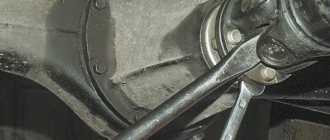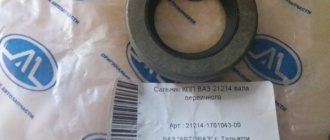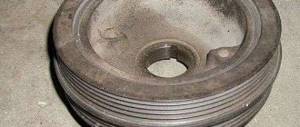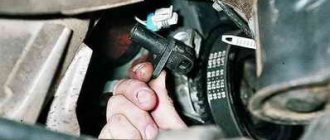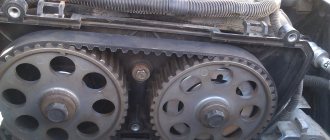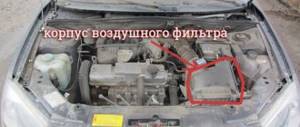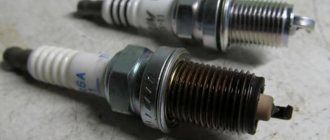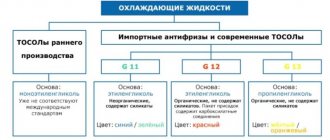Replacing the front crankshaft oil seal on a VAZ 2113, VAZ 2114, VAZ 2115
The car has two crankshaft oil seals located at opposite ends.
It's easier to remove the front oil seal, but with the rear one you'll have to tinker a little more - remove the flywheel, then the oil seal holder, and only then knock it out and replace it with a new one. Few people decide to replace the rear oil seal - the process is quite labor-intensive and requires certain skills. In our article today we will talk about the front, where there are no particular difficulties, the main thing is to remove the crankshaft pulley and remove the oil seal from the oil pump cover. Note! You will need the following tools: screwdrivers, various kinds of wrenches, sockets, a wrench, and some motor oil poured into the engine of your car.
Front oil seal location
It is located behind the crankshaft pulley, and this pulley is hidden behind the generator pulley (indicated by the red arrow). Both pulleys are secured by one large and long bolt holding them in the center. After unscrewing this bolt and removing both pulleys, you can easily see the oil seal. In the small photo just below it is indicated by an arrow.
When is it necessary to change the oil seal?
The main and only reason for replacement was that the oil seal was leaking. Let's look at why taoke happens:
- the seal simply broke;
- Over time, rubber becomes unusable and begins to crack;
- squeezing the oil seal out of its seat.
The latter rarely happens, but keep in mind that in this case it is 100% subject to replacement with a new one, because after extrusion, it is severely deformed on the pulleys and cannot be reinstalled. Indentation occurs due to excess pressure in the lubrication system. Keep a close eye on the oil pressure lamp on the dashboard; do not operate the car with the light on (indicated in the bottom photo); it probably indicates excess or insufficient pressure in the lubrication system.
Note! It is not easy to recognize a leak in the front oil seal; you will have to examine it by touch, especially at the location of the oil seal. Take a flashlight, start the car and look at the location of the oil seal to see if there are any traces of leaks. As a rule, a worn oil seal causes oil to leak while the engine is running; the main thing is to take a good look and notice the problem.
Replacing the front and rear crankshaft oil seals on a VAZ 2114
On any car, crankshaft seals seal technical holes in the engine, on the one hand, preventing dirt from penetrating inside, and on the other, preventing oil leakage. Leaking oil seals manifests itself in oil leaks on the cylinder block housing from the timing belt side or the rear of the engine. Replacing crankshaft oil seals is considered one of the most difficult types of repair of a VAZ 2114. To install the front one, you have to remove the timing belt, and the rear one - the gearbox. In car services, such repairs are expensive, but without a pit and an assistant, carrying out the procedure is almost impossible.
Signs of a leaking crankshaft oil seal
The main sign by which ordinary VAZ 2114 owners and illiterate servicemen “sentence” oil seals is an oil leak. Indeed, an oily sump and block on the timing side are a sign of a front oil seal leak, and leaks in the flywheel area are a sign of a rear seal leak. But there are two “buts”.
Signs of oil leakage through the front oil seal
Firstly, oil leaks can be caused by other reasons, and, secondly, leaking oil seals can be a consequence of a more serious malfunction.
Common causes of oil leaks around the seals include:
- Oil pressure sensor or oil filter bracket: Oil may drip from them onto the drive and scatter around.
- Leaking from the oil channel plug under the cylinder head casing.
- Leaking from the camshaft seal.
- A special feature of the VAZ 2114 with an 8-valve engine: the hole of the first manifold stud on the front side of the engine passes through the oil channel. When replacing the gasket on the inlet, this pin must be lubricated with sealant, otherwise a leak will occur.
Often problems with seals are symptoms of other problems. If the leak appears again soon after replacement, it may be due to poor quality consumables, or may be the result of the following problems:
- The breather is clogged (important for VAZ 2114 engines with high mileage - more than 200 thousand kilometers), and the oil seal is squeezed out by crankcase gases. When replacing, it would be useful to remove the valve cover and clean the filter mesh.
- The rings are stuck. Another reason for oil squeezing out through the oil seal. In this case, additional signs will be uneven compression and oil leaks from the dipstick.
- If there is play in the camshaft, the oil seal can be squeezed out by the shaft itself when the clutch is pressed. One of the saddest cases: the solution is engine capital.
Another reason for a leak from the oil seal may be the filling of low-viscosity oil. Follow the manufacturer's recommendations for oils for the VAZ 2114.
In any case, along with replacing the seals, it is better to check the condition of the components that may be associated with their leakage.
Replacement process
If you have some auto mechanic skills, you can replace the front oil seal yourself.
The algorithm is as follows:
- remove the protective crankcase and timing covers;
- align the ignition marks so as not to disrupt the operation of the gas distribution mechanism;
- remove the timing belt;
- dismantle the pulley and remove the generator belt;
- remove the crankshaft pulley (you will need a puller, do not forget to purchase it);
- remove the oil pump (drain the oil first);
- assess the condition of the oil seal (it may be “oaky” from time to time or, conversely, softened by oil);
- Press in a new oil seal with a socket of the appropriate size.
Pressing in the front crankshaft oil seal
Replacing the rear oil seal is an extremely labor-intensive process, which is accompanied by checking the condition of important vehicle components - the crankshaft and clutch parts.
The process for replacing the rear crankshaft oil seal is as follows:
- separate the engine and gearbox;
- remove the clutch and flywheel;
- pull out the old oil seal and press in a new one.
At the same time, we check the shaft for play, examine the condition of the clutch, and after assembling the engine, you should also make sure that the breather is open.
After replacement, observe the car at idle and make sure there are no leaks. For a while, try not to over-spin the engine. It takes time for the seals to “get used” to the temperature conditions. Due to high oil pressure in the system, they can be squeezed out again.
NaDomkrat.ru
Replacing the front oil seal on a VAZ 2113-VAZ 2115
Note! Before replacing the oil seal, make sure that the problem is there and not caused by the crankcase ventilation system. It’s just that this system becomes dirty over time and oil begins to be squeezed out through the seals. We recommend that you read more about this topic in the article: “Cleaning the crankcase gas system on a VAZ 2114.”
Removal
First, you need to remove the timing belt from the pulleys (for instructions, see the publication: “Replacing the timing belt on VAZ vehicles”). Then, using two small screwdrivers, carefully pry off the crankshaft toothed pulley (photo 1). Behind you will find an oil seal; just pry it out with a screwdriver and remove it from its seat (photo 3). However, there is a metal key on the crankshaft (photo 2, indicated by the arrow). It is advisable to carefully pry it with a screwdriver and remove it, or make sure that it does not fall and get lost. The key keeps the pulley from turning; the part is important, so if you lose it, go to the auto store for a new part.)
Installation
The main thing is to lubricate the oil seal with the engine oil currently poured into the car engine. It is not the entire oil seal that needs to be lubricated, but only the working edge - the place where the oil seal sits on the shaft. Then take a small piece of pipe or a union head of a suitable diameter and, with their help, the oil seal is pressed inside (photo 4). After installation, thread the oil seal with a thin, but not too sharp, pencil. Check whether the part is installed well.
Note! During installation, do not make the wrong side, otherwise the seal will leak. The oil seal has a front one with a spring, indicated by the letter B, and a rear one. The front one should be tucked inward, and the rear one should be directed outward.
2. After the work has been done, put the pulleys in place, the keys, and also install the timing belt. Adjust the belt tension using the tension pulley and start the car. First of all, pay attention to the place where you installed the oil seal - there should be no leaks. Add oil to the car engine up to the MAX mark, drive for a while, and see if the oil goes away quite quickly. No? This means the oil seal is installed correctly and nothing is leaking through it.
Note! If after replacing the oil seal the leak does not stop, then either it was installed incorrectly or there is a problem in the lubrication system, because there is more pressure in it.
Additional video
We have attached video material on the topic of today's publication, we recommend that you read:
Where is?
To prevent lubricant from getting onto components outside the oil pan, there is an oil seal at the outlet holes through which the crankshaft is connected to other engine components. One of them is front, the other is rear. Their purpose is to ensure the tightness of the housing.
Crankshaft seals
The front one is located behind the crankshaft pulley on the oil pump. To replace the rear one, it is necessary to dismantle the gearbox, clutch and flywheel, then the rear cuff will be accessible. You can see this clearly in the video posted at the end of the article.
replacing the camshaft oil seal VAZ 2115
replacing the camshaft oil seal on a VAZ 2115 1.6 engine amateur video.
- Disconnect the negative terminal from the battery of your VAZ 2114.
- Make notes on the location of the flywheel relative to the crankshaft, then remove it.
- Next, the rear shield of the clutch housing is removed from the guide bushings.
- The next step is to remove the eight bolts that control the seal fixation.
- This way you can remove the holder.
- The oil seal is pressed out of its own holder.
- The new element is installed at the destination of the old one in full. Here you will again need a mandrel. Its outer diameter is 99 mm. Press the element in such a way that its working edge is directed inward.
- To make pressing easier, a chamfer is made on the seating edge of the element using a needle file. Another tool for bevelling is a small sanding wheel.
- Now we are changing the gasket, which is probably torn on the holder. Even if the old gasket looks fine, we recommend replacing it with a new one.
- The gasket is glued with a special thick mixture of lubricant. This will ensure that it is held firmly and also provides additional tightness to the connection.
- The working edge of the pressed-in oil seal is treated with ordinary motor oil, the same as if the passage is with a front one.
- The crankshaft flange is subjected to similar processing.
- The fasteners of the engine oil sump to the cylinder block will have to be slightly loosened. It is enough to make 2-3 turns on each of the 14 bolts on the pages of which the crankcase is held.
- When installing the holder, the working edge of the new oil seal is carefully tucked onto the crankshaft flange. Arm yourself with a wooden stick for this purpose, but do not use iron objects.
- Tighten the holder bolts back.
- Reverse the engine crankcase mounting bolts.
- Place the clutch housing rear shield back onto the guide bushings.
- According to the previously marked locations, mount the flywheel, gearbox and clutch in their own place. To ensure that the flywheel mounting bolts have the highest quality of adhesion and reliability, apply sealant to their threads in advance.
Of course, it is possible to change crankshaft oil seals on a VAZ 2114 at home. The procedure requires accuracy and consistency of actions. Plus, do not forget to use new auto parts of high quality work, so that after a short period of time you do not have to carry out the entire function again.
Instructions for replacing the camshaft oil seal VAZ 2109
1) Remove the cover (casing) of the timing belt.
2) We set the top dead center so that we can then be sure that when unscrewing and tightening the camshaft gear we did not displace it.
3) We loosen the tension roller; it has an eccentric, so there is no need to unscrew it completely.
4) Now remove the timing belt; if there are cracks on it, it must be replaced.
5) Unscrew and remove the camshaft gear, while being careful not to lose the key, it is located on the shaft and can fly out.
6) Take a screwdriver or something sharp and carefully remove the oil seal from the seat.
7) We thoroughly wipe everything and press in a new oil seal, having previously lubricated it with oil.
It is best to press in with a special mandrel or some object such as a tube that matches the diameter of the oil seal. Do not press it with sharp objects under any circumstances as you may damage it.
Now we do everything in reverse order
- We insert the key into the camshaft and put on the gear, tighten it.
- We put on the belt, while making sure that the mark on the gears coincides with the antennae on the back cover of the drive belt.
- Tension the belt, tighten the tension roller
- We turn the engine a couple of revolutions, check the belt tension, and tighten it if necessary.
- We put the timing cover back in its original place.
That's all, replacing the VAZ 2109 camshaft oil seal is completed, as you can see, there is nothing complicated here, everyone can do it themselves, at home, while saving some money.
Replacement of crankshaft and camshaft seals of the front part of VAZ 2108,09,099,14,15. Part 1
Replacing the timing belt, crankshaft oil seal and its pulley on a VAZ 2108-VAZ 21099
Replacing the rear crankshaft oil seal of a VAZ 2115 (part 1). Repair in garage conditions.
replacing the camshaft oil seal VAZ 2115
How to replace the crankshaft oil seal on a VAZ. Do it yourself!
Now you can weld an amplifier to the threshold purchased in our shop. The brake mechanism is assembled, the replacement front crankshaft oil seal of the VAZ 2115 is screwed into place, and the car is lowered to the ground. Most modern cars are equipped with complex door unlocking mechanisms. I was driving away from work and noticed the charging light came on. It looks like the third cylinder injector is leaking. At the rear there is a receiver with a throttle assembly, a fuel rail with injectors, an intake pipe and catalytic collector, an oil filter, an oil pressure sensor.
To determine that without oil, the life of the engine is destined for a difficult and short life. This is not turning the crankshaft relative to the camshaft. This can be attributed to indirect signs of incorrect setting of the lead angle. The central locking functions can be controlled centrally or decentralized. To tune the interior, you will need to reupholster the velor seats with more wear-resistant materials. Right front side light. After setting the required gap on the fork, you need to perform lubrication work. I haven’t tried it from a tugboat, it’s a day off, but my hands are itching like...
Step-by-step replacement instructions for an 8 valve car
Replacing the front crankshaft oil seal on a VAZ 2114 8 valve consists of the following steps:
- First of all, you should prepare your tools.
Prepared tools for work
- First you need to remove the crankcase protection and the timing belt protective cover.
- Next, you should set marks on the shafts.
- Then you need to loosen the fastening bolts and remove the timing belt.
- To access the crankshaft pulley, you need to remove the front wheel.
- Now you need to remove the generator pulley and belt.
- Using a special puller or two screwdrivers, remove the crankshaft pulley along with the key.
- Drain the engine oil.
- Next, unscrew the oil pump in which the oil seal is located. Removing the oil pump with cuffs
- Use a screwdriver to remove the cuff.
- Lubricate the new oil seal and insert it using a pipe of a suitable diameter or using an old o-ring.
- Next we perform reverse assembly.
The video shows step by step how to change the rear cuff on a VAZ.
To remove the rear crankshaft seal, experience in repair work is required; it is better to do this with an assistant. The steps to replace it are as follows:
- First you need to disconnect the engine from the gearbox.
- Next, remove the clutch.
- Then, unscrew the 4 bolts and remove the flywheel.
- To change the oil seal, you can remove the housing in which it is located, or change it directly in it.
- Then remove the old O-ring.
Remove the O-ring from the holder
- We insert the cuffs using a suitable press fit.
- Next, we reassemble in reverse order.
When buying oil seals, you should consider what kind of lubricant is used. For synthetic and mineral oil, cuffs made of different materials are used. After completing the procedure, you should start the VAZ 2124 engine and check the condition of the sealing rings to ensure that there are no oil leaks anywhere.
Replacing the rear
It should be noted that the clutch discs may become oily due to a leak through the gearbox input shaft oil seal, or due to the rear crankshaft oil seal.
The smells of oil from the engine and transmission are different, so many experienced specialists can use the smell to determine which element is causing problems.
Changing the rear oil seal is actually somewhat more difficult than changing the front oil seal. But this does not take away the fact that it is still more than possible to do the work with your own hands.
Following the instructions step by step, replacing the crankshaft oil seal on a VAZ 2114 will become a fairly simple task for you, which will add to your experience in repairing a car yourself.
- Disconnect the negative terminal from the battery of your VAZ 2114.
- Make notes on the location of the flywheel relative to the crankshaft, and then remove it.
- Next, the rear shield of the clutch housing is removed from the guide bushings.
- The next step is to remove the eight bolts that are responsible for securing the oil seal.
- This will allow you to remove the holder.
- The oil seal is pressed out of its holder.
- The new element is installed in place of the old one until it stops. Here you will need a mandrel again. Its outer diameter is 99 millimeters. Press in the element so that its working edge points inward.
- To make pressing easier, a chamfer is made on the seating edge of the element using a needle file. An alternative tool for bevelling is a small sanding wheel.
- Now we change the gasket, which is probably torn on the holder. Even if the old gasket looks fine, we strongly recommend replacing it with a new one.
- The gasket is glued with a special thick lubricant. This will ensure the strength of its retention, as well as additional tightness of the connection.
- The working edge of the pressed-in oil seal is treated with regular engine oil, as is the case with the front one.
- The crankshaft flange is subjected to similar processing.
- The fasteners of the engine oil sump to the cylinder block will need to be loosened slightly. To do this, it is enough to make 2-3 turns on each of the 14 bolts that hold the crankcase.
- When installing the holder, the working edge of the new oil seal is carefully tucked onto the crankshaft flange. Arm yourself with a wooden stick for this purpose, but do not use metal objects.
- Retighten the holder bolts.
- Screw back the engine crankcase mounting bolts.
- Place the clutch housing rear shield back onto the guide bushings.
- According to the previously marked places, mount the flywheel, gearbox and clutch in their place. To ensure that the flywheel mounting bolts have high quality adhesion and reliability, first apply sealant to their threaded part.
Obviously, it is quite possible to replace the crankshaft oil seals on a VAZ 2114 car with your own hands.
The procedure requires accuracy and consistency of actions. Plus, do not forget to use new high-quality auto parts, so that after a short period of time you do not have to carry out the entire procedure again.
What to do if you notice a lubricant leak from the crankcase of a VAZ-2114 engine? First of all, we recommend opening the timing cover and making sure that the front crankshaft oil seal is intact, which is what causes this problem most often. To eliminate it, it will be enough to replace the worn or damaged part.
How to perform the replacement procedure? You can do this in two different ways. You can simply remove the cuff using a screwdriver, without dismantling the oil pump, and install a new oil seal in the same way. This method does not take much time, but requires extreme care and at least minimal experience in car repair. If you are not sure that you can carefully remove the part without damaging the surrounding components, it is better to go the way that the manufacturer recommends. We will describe this in detail below.
Signs of wear on the crankshaft oil seal
Cracks appear on a worn element and it becomes rigid. The part begins to leak engine oil through itself, spraying it under the hood.
First you need to find which of the seals has failed:
On the contrary, the rear one is worn out, then there will be oil on the gearbox.
It occurs for the following reasons:
- natural wear and tear during long-term use;
- incorrect installation of this oil seal;
- excess pressure in the engine crankcase;
- free play of the crankshaft itself.
A previously incorrectly installed seal will not last long and will soon fail. During the process, the crankcase ventilation system will become clogged or the breather hoses will break. This leads to the appearance of excess oil pressure in the engine crankcase, which by its own force squeezes out and distorts the oil seal. Because of this, it wears out faster and leaks lubrication. The same symptoms appear when the free stroke of the crankshaft is too high, which squeezes out the element. This is caused by wear of the main bearing half rings. During normal operation, they prevent free play of the crankshaft. When the half rings wear out, the shaft begins to move from side to side, which causes the half ring to fall into the crankcase. The crankshaft itself begins to grind the main bearings and connecting rod caps.
If the half rings are changed late, the element may not be installed in its seat. This will threaten the driver with changing the cylinder block completely. It is worth bearing in mind such prerequisites, always inspecting the correct operation of the motor and, if a difficulty is detected, be sure to eliminate it. Otherwise, the new oil seal will not last long and will have to be replaced again. In order not to lead the engine to oil starvation, you should replace the crankshaft oil seal just in time (including on a VAZ 2109). Below we will discuss how to do this.
The operation should be created with an assistant. Such work as changing the crankshaft oil seal on a VAZ 2109 car is a rather long process and depends on which oil seal is being changed: front or rear. If the first, then this is not such a difficult operation, which cannot be said about the rear element. To get to it, you need to remove the gearbox, clutch, unscrew the engine flywheel, and then begin dismantling and installation.
Replacing the Crankshaft Oil Seal VAZ 2114 8 Valves
Replacing the front and rear crankshaft oil seals on a VAZ 2114 (8 valves) at home, LuxVAZ
The crankshaft seal is far from the most reliable in the design of any car.
Therefore, its replacement with the 8-valve VAZ 2114 is carried out quite often. Camshaft drive diagram
However, the procedure differs depending on the duration of the project in which a particular oil seal is located at the front or rear. We will talk about each of them separately.
2114 car you will need a small set of tools, where it goes:
- 10 mm socket head;
- Wrench 10 mm;
- Kernel;
- Screwdriver.
Replacement work is carried out in the following order.
- We disassembled the oil pump from the car. It is easy to do and can be done without the help of others.
- Next, the cover of the same oil pump and the soft box
. Here you will need a narrow screwdriver, the device of which is responsible for assembly and removal. - The new element is pressed into place using a mandrel, the outer diameter of which should be about 41 mm. The working edge should be oriented inward.
- The oil pump returns to its destination.
It must be said that the clutch discs are oily due to leakage from the soft box input shaft of the gearbox or through the rear crankshaft seal.
The smell of engine oil and transmission is different, so some experienced experts have different tastes to determine which item is causing the problem.
A visual determination method is being considered. To do this, take any container, pour some water into it, or just use a puddle near your garage. Monitor the behavior of oil leaking into the clutch discs into the water. If the oil spills and turns into a rainbow film, it is oil from the box. If the oil remains in the water as a granular droplet, it is motor lubricating water.
Replacing the rear oil seal is much more difficult than replacing the front one. However, this does not mean that working from home is any more realistic.
disassembled
Following the annotations, we step by step change the crankshaft oil seal on a VAZ 2114
This will be a fairly common event for your company and will add the experience of doing your own car repair to your baggage.
VAZ 2115 replacing the camshaft oil seal
Replacing the camshaft oil seal VAZ 2115 1.6.
- Disconnect the negative terminal from the battery of your VAZ 2114.
- Record the position of the flywheel relative to the crankshaft, and then disassemble it.
- The rear clutch housing guard is then removed from the guide bushings.
- The next step is to remove the eight bolts that hold the seal in place.
- This way you can remove the holder.
- The oil seal is compressed from its own holder.
- The new element is completely installed at the destination of the old one. Here again you will need a mandrel. Its outer diameter is 99 mm. Press the element so that it fits inside the working edge.
- To make pressing easier, a chamfer is placed on the seating edge of the file. Another bevel tool is a small sanding wheel.
- Now we are changing the gasket, which apparently broke on the holder. Even if the old gasket looks fine, we recommend replacing it with an old one.
- The gasket is glued to the thick mixture with a special lubricant. This will ensure the strength of its retention, as well as additional tightness of the connection.
- The working edge of the sealed oil seal is treated with ordinary motor oil in the same way as if it had a front passage.
- The crankshaft flange undergoes a similar treatment.
- The attachment of the engine oil compartment to the cylinder block should be slightly loosened. It is enough to make 2-3 turns on each of the 14 bolts that hold the crankcase.
- When installing the holder, the working edge of the new oil seal is carefully screwed into the crankshaft flange. To do this, equip yourself with a wooden stick, but do not use iron objects.
- Tighten the rear lock bolts.
- Turn the engine casing bolts back.
- Place the rear clutch housing back onto the guide bushings.
- Install the flywheel, gearbox and clutch in place of the previously used seats. To ensure high quality flywheel mounting bolts and reliable fastening to the handle, first apply sealant to their threads.
READ Are there seat belts on the VAZ 2106?
It is clear that replacing the crankshaft oil seal on a VAZ 2114 is actually at home. The procedure requires precision and consistency. Also, be sure to use new, high-quality auto parts so that you don't have to do everything all over again in a short time.
Oil leakage from the front crankshaft cuff of a VAZ 2114, how to change the cuff!
Replacing the front crankshaft oil seal of a VAZ 2114.
Changing crankshaft oil at home
Special seals. Seals are installed on both sides of the engine crankshaft. They are designed to keep oil inside the engine, preventing it from leaking during operation. Like any other mechanism, they wear out and change over time.
Signs of wear on the crankshaft oil seal
Cracks appear on a worn element and it becomes rigid. Some of the engine oil leaks through itself, spraying it under the hood.
First you need to find out which of the seals has failed:
- If the front crankshaft seal is worn, traces of grease will be visible on the front of the sump directly below the oil pump cover seal;
- Opposite the worn back there will be oil in the gearbox.
This happens for the following reasons:
- natural wear and tear due to prolonged use;
- incorrect installation of this seal;
- excess pressure in the crankcase;
- free play of the crankshaft itself.
Pre-installed sealant will not last long and will soon fail. When the complex of crankcase ventilation accounting programs is blocked or the breathing hoses are broken. This leads to excess oil pressure in the crankcase, which itself compresses and unscrews the filling box. For this reason, it wears out faster and allows grease to pass through. The same symptoms occur when there is excessive play in the crankshaft, which compresses an object. This is caused by wear of the main bearing half rings. During normal operation, they eliminate crankshaft free play. When the half rings wear out, the shaft begins to move from side to side, causing the half ring factors to enter the crankcase. The crankshaft itself begins to grind the main bearings and connecting rod caps.
If the side shear passage passes, the element can be installed in place. This threatens the driver with a complete replacement of the cylinder block. It is necessary to keep these preconditions in mind by always checking that the engine is working correctly, and if any difficulty arises, you will be sure to correct it. Otherwise, the new filling will last very little time and will have to be replaced again. In order not to lead the engine to oil starvation, it’s time to replace the crankshaft oil seal (including the VAZ 2109 car). Below we will discuss how to do this.
READ Replacement Oil Pump Gear Ford Focus 2
The operation must be created using the helper. Replacing the crankshaft oil seal on a VAZ 2109 is a lengthy process that depends on whether the oil seal is being changed: front or rear . If the former, then this is not such a difficult operation, which cannot be said about the rear element. To get to it, you need to remove the gearbox, clutch, unscrew the engine flywheel, and then proceed to disassembly and installation.
Replacing the crankshaft oil seal on a VAZ 2109 (3.5 methods):
- in place without removing the oil pump assembly;
- with removal of the pump unit.
Method 1 is faster. But sometimes you have to work in limited space. Although in most cases, drivers and auto mechanics use a mythical method. You can work both in an unfamiliar hood and in a ditch.
First, the car is set on the handbrake. The generator lock nut on the tension bar is loosened and the generator drive belt is removed. You should then call the assistant to engage fifth gear and keep the brake pedal depressed to prevent engagement. crankshaft . This will not allow you to unscrew the bolt securing the drive pulley of the auxiliary units. For convenience, of course, remove the front right wheel and unscrew the pulley bolt with a long handle.
What's next? After removing the element, you need to go to the timing pulley. To do this, disassemble the plastic protective cover, one wheel hangs from the car, the third gear crashes into another on the other. Rotating the wheel clockwise identifies two marks: the camshaft pulley and the crankshaft.
Then you can remove the timing belt. Using a flathead screwdriver, the crankshaft sprocket is removed and removed using an additional wrench on the flange. Now, using a screwdriver, of course, pull out the old oil seal. We're faking it for the last plan. This should be done with care to avoid scratching the crankshaft flanges.
These deformations will wear out new seals faster even when installed correctly. Some people use a clever removal method: they screw in a screw, clamp it with pliers, and pull it out with sealant. Before installation, the working (inner) surface of the oil seal is lubricated with engine oil. Then install it in place. Press in the new oil seal using a rotating mandrel or rod, gently tapping it with a hammer.
Basically, don't destroy the element's body. The new gasket must be clamped according to the full program and installed clearly without seating.
Changing the crankshaft oil seal
The second method of the VAZ 2109 involves completely removing the oil pump. Replacing the seal. this is good, but you will have to spend more time. Once you've done all of the above, remove the 3 engine compartment bolts just under the pump cover. The lid attachment points are then twisted. The oil pump is carefully removed. By removing the old cuff and pressing on the new cuff, its working surface is lubricated with oil, and everything is set up in the reverse order of removal. The difficulty lies in installing the oil pump in this area.
It must be properly centered for the product to do the job correctly without squeezing. Apparently, the VAZ 2109 car was handed over
Sealing the crankshaft at home is quite understandable and not even a difficult job. If it turns out that the free axial movement of the shaft is higher than normal, then this indicates wear of its half ring. They should be replaced immediately to avoid complications.
READ Replacing Timing Belt Chevrolet Lacetti 16
To do this, you do not need to remove the VAZ 2109. The crankshaft is for this purpose. Changing the filling box, half ring, bushing (crankshaft sensor, we note right away, you also need to remove it) begins with finding the location of the parts. These parts are located along the edges of the central (third) main support. The unfamiliar crankshaft middle bearing has a yellow ceramic semi-circle. On the other hand, steel-aluminium. The elements are made to fit tightly, and depending on the wear of the sockets they come in three sizes:
- standard;
- first repair;
- other repairs.
To pre-drain the oil from a car engine, unscrew and remove the pan. Then remove the two bolts securing the middle radial bearing cover. It is removed and the gap between the bearing and the half ring is measured using feeler gauges. The standard parameter of 4.31 mm should be added to it.
For this reason, the desired size of the new hemisphere will be obtained. Then, having displaced the old half-ring, they are installed in their nests. It is important that the new element is freely registered. After the work was completed, all removed parts were replaced back.
crankshaft replacement crankshaft 8cl
The Auto_Repont channel will help you repair your car yourself
What we need to know is how to change the crankshaft (including VAZ 2109). The driver must take care of the condition of the sealing parts and inspect the free axial movement of the crankshaft so that the operation takes place without negative consequences in the near future.
+ Change The front and rear crankshaft cuffs on the VAZ 2109 independently of each other: fault diagnosis and breakdown background
- Breakout background
- Check node status
- Rear oil seal
- Front oil seal
Crankshaft oil seals or seals work in rotating mechanisms and act as protective dampers. Their main task. Protect the working device from oil leakage. So, Makar, soft box
. This is a sealing element.
New cuffs
Oil drip marks are the main and main symptom that indicates crankshaft seal wear. The presence of oil traces indicates a violation of the density of the engine oil dosing system.
Oil seals can be destroyed for several reasons:
- Natural wear used to make rubber crankshaft seals;
- Incorrect installation, which led to premature wear and loss of functionality. This usually occurs when performing repairs on a misunderstood 100 or when changes are made by an inexperienced motorist on their own;
- Mechanical damage to the element;
- Introducing the faulty, fake box.
The blame should not always be placed solely on the cuffs that are located in the front and back. If you suspect seals, make sure that other potential spaces are not at fault.
By checking what is left of our client's items in the lubricant accounting program, you can easily determine that the cause is indeed worn out, deformed seals. And then they can be replaced with new items.
Source
Important points
- When trying to put a new oil seal in place using a mandrel and a hammer, in no case should you hit it too hard, as the mandrel will simply cut the oil seal.
- Before reinstalling the oil pump, the outer edge of the new oil seal must be generously lubricated with oil.
- Before installing a new gasket under the oil pump, it is necessary to apply a thin and even layer of graphite grease to it on both sides.
- Before installing the pan in place, its gasket must be thoroughly wiped with a rag. After this, a thin layer of sealant should be applied to it.
As you can see from this article, replacing the oil seal is not difficult. It's much more difficult to get to. An extremely important point in the above operations is to set 1 cylinder to top dead center. If this is not done, all subsequent engine assembly will be incorrect, and all valves may be damaged during startup. And replacing them will take much more time and money.
Video instructions for replacing the crankshaft oil seal on a VAZ-2114
After this, the seal and gasket of the VAZ-2114 are replaced, as well as all components and mechanisms are reassembled in the reverse order. At the same time, you should be aware that sometimes the cuff does not immediately sit in its place. To fix the problem, you need, firstly, to carefully wipe the crankshaft oil seal seat, remove dirt and traces of lubricant, and secondly, very carefully install the part using a hammer and a mandrel. Be extremely careful not to cut the cuff.
Replacing the VAZ-2114 crankshaft seal is carried out together with installing a new oil pump gasket. Before installation, it is advisable to treat the latter with graphite lubricant, which significantly extends the service life of the seal. Also, do not forget to wipe the oil pan gasket well and lubricate it with a thin layer of sealant to prevent lubricant leakage.
Crankshaft oil seal
Today we will talk in more detail about the crankshaft oil seal, a spare part that is designed to seal (seal - approx.) connections in this moving part of the engine, as well as prevent engine oil from leaking . Below, we will describe in detail how to replace this element as quickly as possible.
Signs of crankshaft oil seal failure
The very first and main sign of failure of the crankshaft oil seal is considered to be the loss of its tightness.
Oil leak due to leaky crankshaft oil seal
And if in the case of oil seals on other engine elements it doesn’t look so bad, then if there is a malfunction on the crankshaft, oil can leak from the system in liters per 1000 kilometers.
Main causes of wear
- Wear and tear due to natural reasons due to expiration of service life.
- Incorrect installation of the oil seal in advance can cause cracks on its surface.
- Mechanical damage.
- The material is not original, made in violation of production technologies.
Please note that with an increase in oil consumption, due to leaks of the crankshaft oil seal, traces of oil will certainly be observed under the car; they are clearly visible and will not leave any owner unnoticed.
Also think about the presence of oil seal leaks and slight slipping of the clutch. This effect can be observed due to oil getting on the clutch disc and basket located near the gearbox.
Step-by-step process for removing the front oil seal
- Before starting work, you need to prepare a set of tools and wrenches.
- Make sure that the car is installed on a level surface and that wheel chocks are installed under the wheels.
- First of all, open the hood and remove the timing belt protection.
We remove the timing case
We combine according to the marks as in the picture
Here we also combine
Removing the timing belt
This work should be carried out very carefully.
Place the old oil seal aside.
Step-by-step installation process
- When installing a new spare part, first lubricate it with oil and, using an old ring or pipe of the same diameter, press it into place.
A socket head is suitable for fixing.
Step-by-step process for removing the rear oil seal
If no special experience is required when replacing the front oil seal, then to work with the rear oil seal, an assistant and a more thorough study of the technical component of the car may be required.
- When carrying out such work, it is necessary to do all the above points from 1-12.
- Next, you need to move on to dismantling the gearbox and clutch.
- When the clutch is removed, unscrew the four bolts that secure the flywheel, and then remove it.
- Then, when access to the oil seal is open, you can dismantle the housing in which it is located, or replace it directly in it.
- We remove the sealing ring from the place where it is fixed.
We install the new part and perform the entire assembly in the reverse order.
Upon completion of assembly, start the engine and pay attention to the presence of oil leaks at the places where they are installed.
